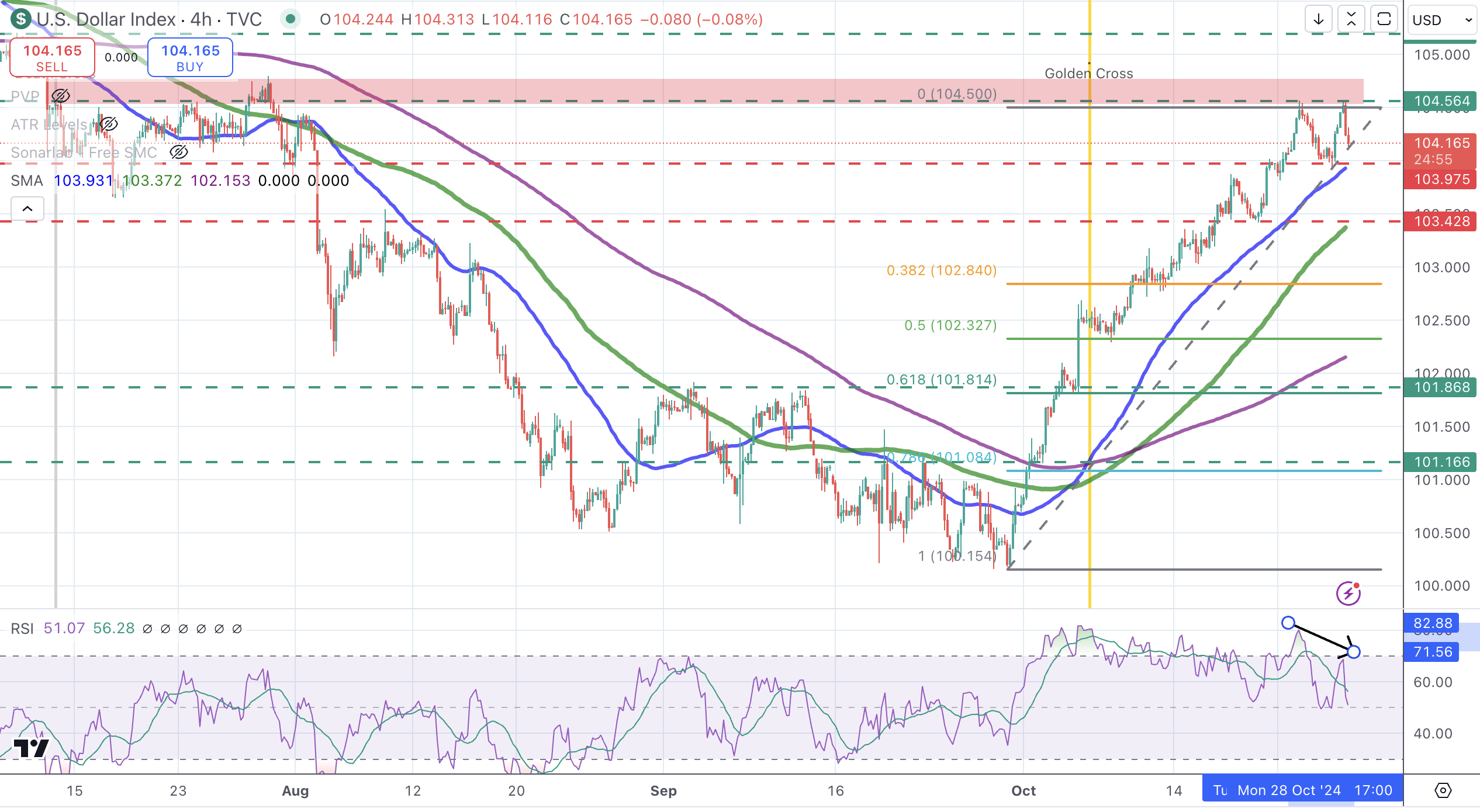- US Dollar corrects lower on Monday with the market bracing for a data-packed week in the US.
- Hopes of gradual Fed easing and speculation of a Trump win are keeping USD's downside limited so far.
- The US Dollar is on track to its best monthly performance in the last two years.
The US Dollar (USD), as measured by the US Dollar index DXY, opens the week in a softer tone weighed by lower US Treasury yields as investors brace for an eventful week. The third quarter’s US Gross Domestic Product (GDP), the Personal Consumption Expenditures (PCE) Price Index, and the Nonfarm Payrolls (NFP) report are all out in the coming days.
The broader Dollar trend, however, remains positive as investors dial back hopes of aggressive interest rate cuts by the Federal Reserve (Fed). A raft of strong US economic data and speculation of former US President Donald Trump winning the US presidential election on November 5, with his inflationary policies, are lifting US Treasury yields and dragging the US Dollar higher.
Daily digest market movers: The US Dollar consolidates as investors await growth and labour data
- The Greenback is trading within the previous week’s range, near three-month highs, and on track to a 4% rally in October, on its strongest monthly performance in two years.
- The solid labour figures have consolidated the idea that the US economy is outperforming the rest of the major economies, which will force the Fed to slow down its easing cycle.
- The CME FedWatch tool is pricing a 96% chance of a 25 basis point (bps) cut next week. Two weeks ago, the market was split between a 25 or a 50 bps cut in November.
- The US economy is expected to show a steady 3% yearly growth in the third quarter. In the current global context, these are solid numbers, consistent with a tight labour market and steady inflation.
DXY technical outlook: DXY correction approaches a key support area at 103.95
The technical picture shows the DXY index is gathering bearish traction, with price action approaching 104.95, where the 4-hour 50 Simple Moving Average (SMA) meets last Friday's low. The 4-hour Relative Strength Index (RSI) indicator is showing a bearish divergence, and US yields are pulling back, altogether suggesting that a deeper correction might be in progress.
A confirmation below 103.95, would increase pressure towards 103.45 (last week’s low), ahead of the 38.6% Fibonacci retracement, at 102.85 .Resistances are at the 104.55-104.80 range, and above here, at 105.20.
USD Index 4-hour chart
US Dollar FAQs
The US Dollar (USD) is the official currency of the United States of America, and the ‘de facto’ currency of a significant number of other countries where it is found in circulation alongside local notes. It is the most heavily traded currency in the world, accounting for over 88% of all global foreign exchange turnover, or an average of $6.6 trillion in transactions per day, according to data from 2022. Following the second world war, the USD took over from the British Pound as the world’s reserve currency. For most of its history, the US Dollar was backed by Gold, until the Bretton Woods Agreement in 1971 when the Gold Standard went away.
The most important single factor impacting on the value of the US Dollar is monetary policy, which is shaped by the Federal Reserve (Fed). The Fed has two mandates: to achieve price stability (control inflation) and foster full employment. Its primary tool to achieve these two goals is by adjusting interest rates. When prices are rising too quickly and inflation is above the Fed’s 2% target, the Fed will raise rates, which helps the USD value. When inflation falls below 2% or the Unemployment Rate is too high, the Fed may lower interest rates, which weighs on the Greenback.
In extreme situations, the Federal Reserve can also print more Dollars and enact quantitative easing (QE). QE is the process by which the Fed substantially increases the flow of credit in a stuck financial system. It is a non-standard policy measure used when credit has dried up because banks will not lend to each other (out of the fear of counterparty default). It is a last resort when simply lowering interest rates is unlikely to achieve the necessary result. It was the Fed’s weapon of choice to combat the credit crunch that occurred during the Great Financial Crisis in 2008. It involves the Fed printing more Dollars and using them to buy US government bonds predominantly from financial institutions. QE usually leads to a weaker US Dollar.
Quantitative tightening (QT) is the reverse process whereby the Federal Reserve stops buying bonds from financial institutions and does not reinvest the principal from the bonds it holds maturing in new purchases. It is usually positive for the US Dollar.
Information on these pages contains forward-looking statements that involve risks and uncertainties. Markets and instruments profiled on this page are for informational purposes only and should not in any way come across as a recommendation to buy or sell in these assets. You should do your own thorough research before making any investment decisions. FXStreet does not in any way guarantee that this information is free from mistakes, errors, or material misstatements. It also does not guarantee that this information is of a timely nature. Investing in Open Markets involves a great deal of risk, including the loss of all or a portion of your investment, as well as emotional distress. All risks, losses and costs associated with investing, including total loss of principal, are your responsibility. The views and opinions expressed in this article are those of the authors and do not necessarily reflect the official policy or position of FXStreet nor its advertisers. The author will not be held responsible for information that is found at the end of links posted on this page.
If not otherwise explicitly mentioned in the body of the article, at the time of writing, the author has no position in any stock mentioned in this article and no business relationship with any company mentioned. The author has not received compensation for writing this article, other than from FXStreet.
FXStreet and the author do not provide personalized recommendations. The author makes no representations as to the accuracy, completeness, or suitability of this information. FXStreet and the author will not be liable for any errors, omissions or any losses, injuries or damages arising from this information and its display or use. Errors and omissions excepted.
The author and FXStreet are not registered investment advisors and nothing in this article is intended to be investment advice.
Recommended content
Editors’ Picks

AUD/USD recovers further to 0.6000 despite escalating US-China trade war
AUD/USD is building on its recovery from its lowest level since March 2020, retesting 0.6000 in Wednesday's Asian trading. The pair's upside appears elusive as officials confirmed that the US will proceed with a sweeping 104% tariff on Chinese imports starting this Wednesday.

USD/JPY: Japanese Yen strengthens further as recession fears boost safe-haven demand
The Japanese Yen continues to benefit from US tariffs-inspired global flight to safety. Hopes for a US-Japan trade deal further underpin the JPY amid sustained USD selling. The divergent BoJ-Fed expectations support prospects for deeper USD/JPY losses.

Gold price jumps back above $3,000 amid trade war threat to global growth
Gold price regains positive traction following previous day's failed attempt to surpass the $3,022-3,023 hurdle and retakes the $3,000 psychological mark during the Asian session on Wednesday.

Bitcoin, Ethereum and Ripple target $73,000 BTC, $1,300 ETH, and $1.30 XRP
Bitcoin price hovers around $76,200 on Wednesday after falling 3.59% the previous day. Ethereum and Ripple followed BTC’s footsteps and continued their downward trend.

The Fed is looking at a hefty price level
We are still in thrall to tariffs, the faux-macro “data” driving markets. The WSJ editorial board advised other countries to take their tariffs to zero so that Trump’s “reciprocal” tariffs will have to be zero, too. Cute, but no cigar.

The Best brokers to trade EUR/USD
SPONSORED Discover the top brokers for trading EUR/USD in 2025. Our list features brokers with competitive spreads, fast execution, and powerful platforms. Whether you're a beginner or an expert, find the right partner to navigate the dynamic Forex market.




